29 November 2010
VIDEO: the little stick that could
select 360p if you have slow internet connection
The locals keep on telling me that my stick ain't no good for much else than show.
I should listen to them.
23 November 2010
GEAR: sleeping bag comparison
Extended outdoor pursuits often involve overnighting in locations away from accommodation.
I have been enjoying camping in remote locations for a few decades and most times I have provided my own shelter and bedding.
One item that I regard essential for good nights sleep is a suitable sleeping bag.
Second to some form of shelter (not always) the sleeping bag is probably the one item that can make my sleep enjoyable.
Even on very minimalistic trips I have never left it behind.
I have owned countless sleeping bag and currently I have 9 in my wardrobe.
Incidentally all of those sleeping bags are down filled.
I don't own a single synthetic one.
Why?... a couple of reasons.

3 packed-up bags: synthetic (warm-ish), synthetic (cold-ish) and down (warm). Coke can for sizing
When I first started camping (motorcycle days) I was given a synthetic sleeping bag as a present.
Having never owned one before, I was stoked.
It kept me warm at night and that was it.
So why don't I have one now?
My new synthetic sleeping bag was admittedly a bit bulky and used to take up a lot of room on the back saddle of the motorcycle.
With time it became much easier to compress it in the factory storage bag provided.
I thought I was getting good at compressing it but also noticed that it no longer kept me warm on cold night.
My once greatly lofting sleeping bag was now sagging and became thin, all in the short time of about a year.
Eventually I gave up twisting throttles and enjoyed backpacking (bushwalking) more.
My synthetic sleeping bag engulfed half of the space available inside my enormous backpack.
After a couple of outings with experienced bushwalkers I soon realized that synthetic sleeping bags just are not compact nor warm; the other guys all had down filled sleeping bags.
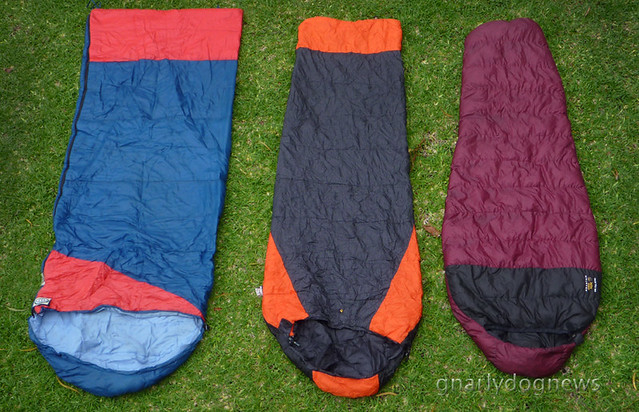
same sleeping bags as in previous photo: out of their compression bag
A down sleeping bag was my next purchase.
I then discovered the other great benefits of a down sleeping bag.
For the same temperature rating my down sleeping bag also weighted half as much.
Much more compact an much lighter: I really liked that.
I also realized that a down sleeping bag had a wider comfort temperature range meaning that it was not too hot during mild nights and still warm enough when the temperature dropped.
It's the natural ability of the tiny down plumes to regulate the comfort level of the sleeper.
Being a natural product down breathes better and will let body moisture escape through the fill better than synthetic.
My down sleeping bags don't suffer from loft loss like my synthetic bag did.
I have one bag that's probably 17 years old and I still use it for the same conditions as when it was new.
If not abused down will really last a long time.
In this comparison I have depicted 3 sleeping bags: two synthetic ones (borrowed) and one down one.
The maroon/black colored one is the down one.
Incidentally is also the warmest.
If size matters (or lack thereof) the photographs speak for themselves.
Just like with my sleeping mats: less is more.

While there is no significant size difference between the bagged (compressed) synthetic bag in the black sack and the down in the orange one, now notice below the two bags out of the compression sack.
The synthetic one offers very little insulation resulting in a comfortable sleep only during warm nights.
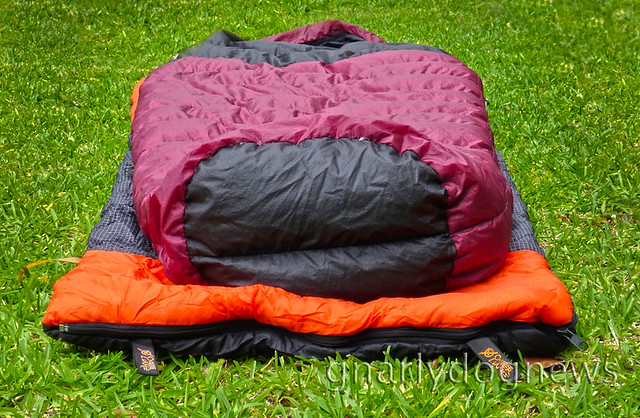
The synthetic bags are also much wider in the feet area.
Some might think that a bit roomy is good in balmy conditions, it becomes cold comfort when the sleeping bag should keep you warm.
Despite what technical claims will try to sell you, a sleeping bag is efficient when it traps the body heat provided by the occupant.
And to date there is no better practical insulator than non circulating air.
By lofting down creates a chamber where the air does not move. The thicker this chamber is the warmer the bag.
Furthermore the sleeping bag should prevent the escape of the warm air created by your body.
A wide hood will be unable to trap this warm air and a sleeping bag without a hood is only suitable for mild temperatures.
In essence, to be warm, a sleeping bag should have:
-decent thickness (loft)
-a fitted hood (preferably 3 dimensional)
- a narrow foot area
There are many other additional features that will make a bag even better, but should not lack the above ones.
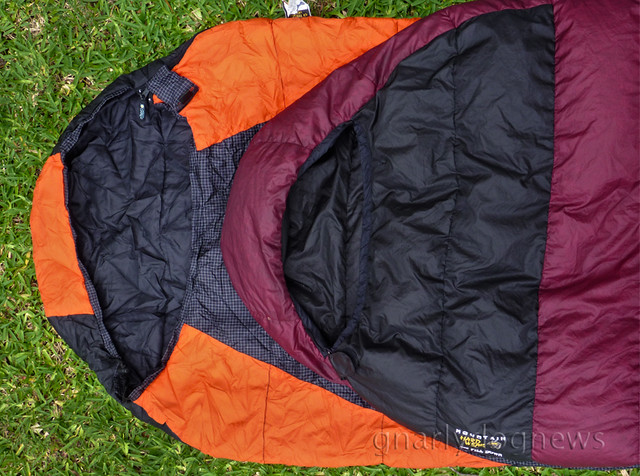
My pictorial comparison is however biased.
The down sleeping bag is a high end one with 800 loft down, close cut, body contoured.
The synthetic ones are entry level offerings from discount stores.
The price difference is substantial but considering that a well looked after down bag will really last you for years, it probably evens out.
There are better synthetic sleeping bags out there but, in my experience, none come close to the performance of down.
The argument that a wet synthetic sleeping bag will keep you warmer than a down one doesn't fly with me.
I wish to never have to sleep in a wet bag, down or synthetic.
All sleeping bags should be protected in a dry bag where getting it wet should not be an issue.
In twenty five years of camping I am yet to experience a shelter leaking enough to really wet my bag and warrant the use of a synthetic one.
Sure, there are some extreme cases where maybe a synthetic bag would be a better choice; It just does not happen around my part of the woods or stretch of coast :-)
Last but not least: cheap, good... pick one.
Down sleeping bags vary a lot in price. It is worth doing a bit of homework before heading to your favorite retailer. There is a lot of good info/reviews available on line; try to avoid the ones that are commissioned by one manufacturer :-)
I have been enjoying camping in remote locations for a few decades and most times I have provided my own shelter and bedding.
One item that I regard essential for good nights sleep is a suitable sleeping bag.
Second to some form of shelter (not always) the sleeping bag is probably the one item that can make my sleep enjoyable.
Even on very minimalistic trips I have never left it behind.
I have owned countless sleeping bag and currently I have 9 in my wardrobe.
Incidentally all of those sleeping bags are down filled.
I don't own a single synthetic one.
Why?... a couple of reasons.

3 packed-up bags: synthetic (warm-ish), synthetic (cold-ish) and down (warm). Coke can for sizing
When I first started camping (motorcycle days) I was given a synthetic sleeping bag as a present.
Having never owned one before, I was stoked.
It kept me warm at night and that was it.
So why don't I have one now?
My new synthetic sleeping bag was admittedly a bit bulky and used to take up a lot of room on the back saddle of the motorcycle.
With time it became much easier to compress it in the factory storage bag provided.
I thought I was getting good at compressing it but also noticed that it no longer kept me warm on cold night.
My once greatly lofting sleeping bag was now sagging and became thin, all in the short time of about a year.
Eventually I gave up twisting throttles and enjoyed backpacking (bushwalking) more.
My synthetic sleeping bag engulfed half of the space available inside my enormous backpack.
After a couple of outings with experienced bushwalkers I soon realized that synthetic sleeping bags just are not compact nor warm; the other guys all had down filled sleeping bags.

same sleeping bags as in previous photo: out of their compression bag
A down sleeping bag was my next purchase.
I then discovered the other great benefits of a down sleeping bag.
For the same temperature rating my down sleeping bag also weighted half as much.
Much more compact an much lighter: I really liked that.
I also realized that a down sleeping bag had a wider comfort temperature range meaning that it was not too hot during mild nights and still warm enough when the temperature dropped.
It's the natural ability of the tiny down plumes to regulate the comfort level of the sleeper.
Being a natural product down breathes better and will let body moisture escape through the fill better than synthetic.
My down sleeping bags don't suffer from loft loss like my synthetic bag did.
I have one bag that's probably 17 years old and I still use it for the same conditions as when it was new.
If not abused down will really last a long time.
In this comparison I have depicted 3 sleeping bags: two synthetic ones (borrowed) and one down one.
The maroon/black colored one is the down one.
Incidentally is also the warmest.
If size matters (or lack thereof) the photographs speak for themselves.
Just like with my sleeping mats: less is more.

While there is no significant size difference between the bagged (compressed) synthetic bag in the black sack and the down in the orange one, now notice below the two bags out of the compression sack.
The synthetic one offers very little insulation resulting in a comfortable sleep only during warm nights.

The synthetic bags are also much wider in the feet area.
Some might think that a bit roomy is good in balmy conditions, it becomes cold comfort when the sleeping bag should keep you warm.
Despite what technical claims will try to sell you, a sleeping bag is efficient when it traps the body heat provided by the occupant.
And to date there is no better practical insulator than non circulating air.
By lofting down creates a chamber where the air does not move. The thicker this chamber is the warmer the bag.
Furthermore the sleeping bag should prevent the escape of the warm air created by your body.
A wide hood will be unable to trap this warm air and a sleeping bag without a hood is only suitable for mild temperatures.
In essence, to be warm, a sleeping bag should have:
-decent thickness (loft)
-a fitted hood (preferably 3 dimensional)
- a narrow foot area
There are many other additional features that will make a bag even better, but should not lack the above ones.

My pictorial comparison is however biased.
The down sleeping bag is a high end one with 800 loft down, close cut, body contoured.
The synthetic ones are entry level offerings from discount stores.
The price difference is substantial but considering that a well looked after down bag will really last you for years, it probably evens out.
There are better synthetic sleeping bags out there but, in my experience, none come close to the performance of down.
The argument that a wet synthetic sleeping bag will keep you warmer than a down one doesn't fly with me.
I wish to never have to sleep in a wet bag, down or synthetic.
All sleeping bags should be protected in a dry bag where getting it wet should not be an issue.
In twenty five years of camping I am yet to experience a shelter leaking enough to really wet my bag and warrant the use of a synthetic one.
Sure, there are some extreme cases where maybe a synthetic bag would be a better choice; It just does not happen around my part of the woods or stretch of coast :-)
Last but not least: cheap, good... pick one.
Down sleeping bags vary a lot in price. It is worth doing a bit of homework before heading to your favorite retailer. There is a lot of good info/reviews available on line; try to avoid the ones that are commissioned by one manufacturer :-)
18 November 2010
Comparison: Tahe Marine Greenland T vs Sea Spirit
Only in recent years has Australia started to see an influx of imported kayaks.
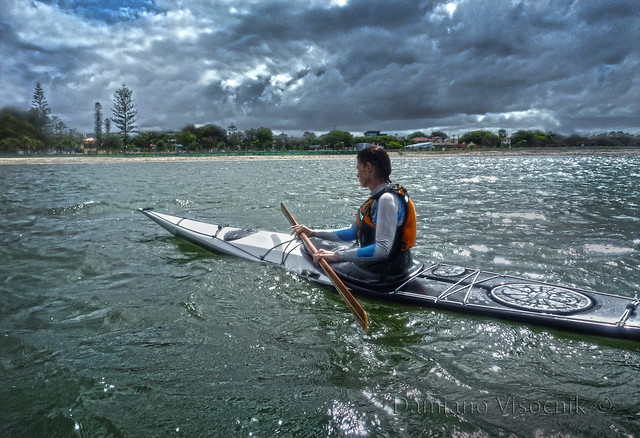
Most paddlers are content learning to roll as a mean to self rescue in an accidental capsize. My circle of friends of dedicated kayakers view rolling more than just a practical skill; they like rolling for the sake of rolling.
Once we learned the basic roll to right ourselves back up we started to explore the possibility of different rolls.
For the last couple of years I have observed a growing trend towards a more graceful paddling style where control of the boat is performed by edging of the hull instead of just pressing on the rudder pedals.
The ultimate kayak for this type of paddling is a Greenland style kayak.
Typically recognized by a low profile with a low rear deck and hard chined hull.
Importer Craig McSween of Adventure Outlet now has 3 different kayaks in stock that follow this design philosophy, all from Tahe Marine.
Already familiar with the performance of the Tahe Greenland, I was interested in trying out the larger siblings: the Tahe Greenland T and the Sea Spirit.
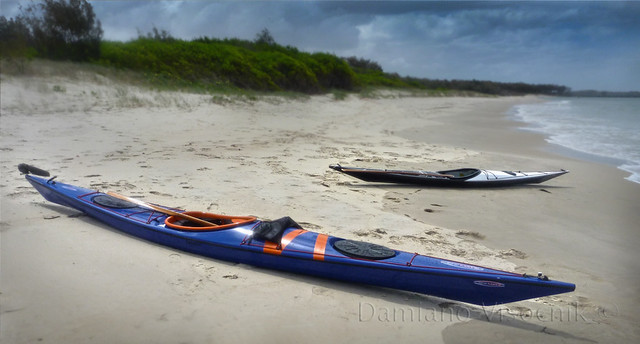
Craig was generous to allow us to test paddle them one afternoon in the relatively sheltered water of the Gold Coast Broadwater.
Conditions were mild: wind gusts of max 15 knots with little or no waves with a max of 1 knot of current.
The Greenland T is regarded as true Greenland form while I think that the Sea Spirit is more an all round kayak of Greenland style.
The T is a bit larger than the classic Greenland, a bit beamier and a slightly higher deck: unfortunately still too small for my large thighs and big feet.
Vanilla fitted the T well and Adventuretess found it roomy enough for possible all day paddles with a bit of wiggle room.
(Vanilla’s personal kayak is an Impex Force5 and Tess’ preferred kayak is her Nordkapp LV).
The T and Sea Spirit have a keyhole cockpit making entry/exit a bit easier than the traditional “ocean style” cockpit on the Tahe Greenland.
We had no means for scientifically measure max speeds of these kayaks but I don’t think they are designed as sprinting vessels.
Having a shorter waterline they accelerated easily and to maintain a cruising speed of 6-7km/h required little effort. The kayaks will start to hit the “hull speed wall” sooner than a long kayak.
However, because of their reduced wetter surface they will be easier to paddle, at club paddling pace, than a longer kayak.
The finish and the attention to detail on Tahe kayaks are superb. The external seam is a narrow black Kevlar tape that has a clear textured finish. Extremely neat.
There were no visible print through areas in the gel coat. The inside of the cockpit is finished with flow coat to prevent any possible fiberglass rash where the body contacts the deck.
The hatch covers (Kajak Sport lids), while very easy to secure/remove, maintained a dry interior during our prolonged rolling session.
select 360p to view vidoe if you don't have a fast internet connection
I believe that Tahe kayaks are a very good value for money alternative to the well established brands offered locally.
They might not be the ultimate bombproof expedition hulls of some British kayaks but they weigh and cost substantially less.
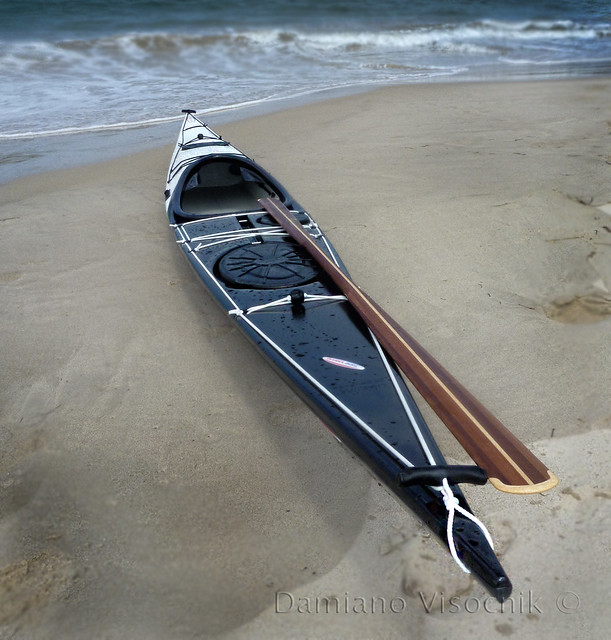
A novice might find the T a bit on the “tippy” side while the wider hull Sea Spirit will instill more confidence, in a beginner.
The T was fitted with a skeg and the Sea Spirit had a rudder (skeg also available).
In beam winds the T weather cocked minimally (a bit of edging was necessary if no skeg deployed). The Sea Spirit displayed no tendency of turning into the wind. Tess didn’t use the rudder (a spring loaded over-stern design that retracts onto the deck when not deployed) while Vanilla used it.

I did not like the rather diminutive back band on the T: maybe it was not adjusted well but kept on sneaking too low on my butt. It would be a real challenge to find a back band that would be supportive enough but still out of the way when lying back over the low rear deck.
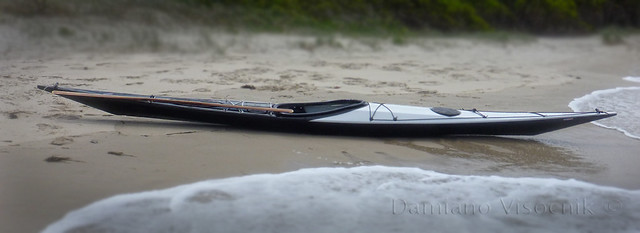
Greenland style kayaks have a hard chined hull that allow for fast maneuvering. Edging drastically changes the footprint of the submerged hull resulting in sharper handling than a round hull.
As expected both kayaks were outstanding rollers, compared to a higher rear decked one.
Both Vanilla and Tess (not expert rollers) could perform moves that are challenging in their own kayaks.
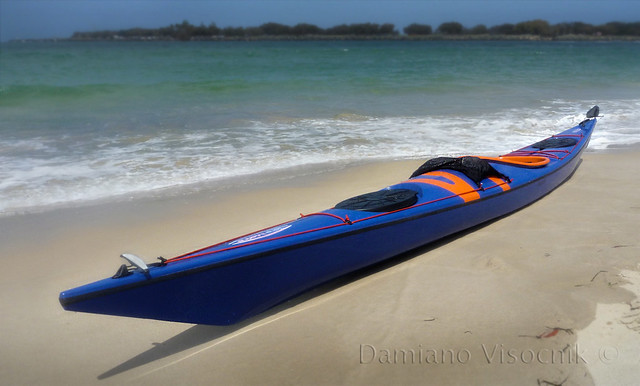
I believe the Sea Spirit would also be an ideal kayak for the beginner aspiring to become a proficient paddler seeking control of the boat.
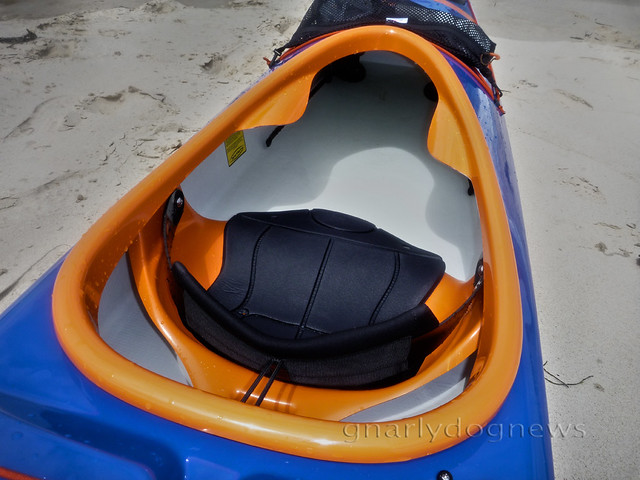
The seats in these kayaks are hung (bolted) from the deck and supported on the hull with a positive fastener that prevents them from swinging and potentially fail due to stress on the hanger (something that has happened on several kayaks of mine).
I found the Sea Spirit’s thigh braces too low and my legs would not fit comfortably under the deck. Unfortunately that is the case with the majority of performance kayaks: my legs are larger than average.
Adventuretess thought that the thigh braces were great. Vanilla would like to see them just a bit higher (or possibly modified by cutting away a small section of fiberglass).
Tahe offers solid foot pegs that are really easy to adjust, even while seated in the cockpit.
Swapping foot reach between Vanilla and Tess was a breeze: no need to undo any bolts or force a stubborn footpegs into the new position. On long paddles, if needed, one can simply reach below deck, twist a little shaft and reposition the pegs in a different location.
The Sea Spirit had only two hatches and lacked the typical day hatch behind the cockpit. Instead it had a nice low profile mesh bag in front of the cockpit.
I like Tahe’s philosophy on this one: to be able to offer a budget kayak (current retail of under $2600) they reduced the features instead of the quality.
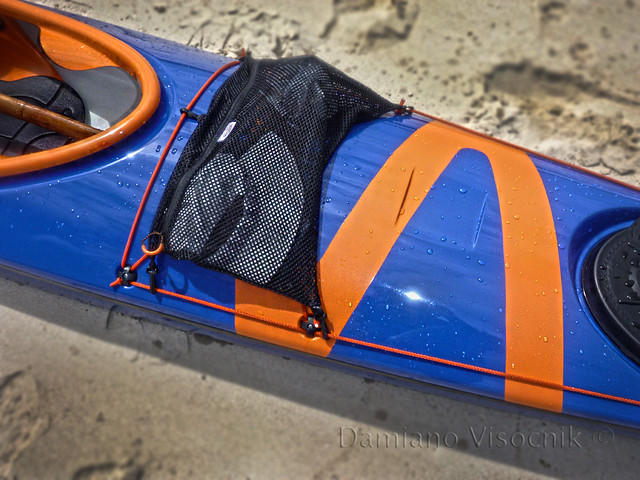
So far I have only had the opportunity to trial just a few of the kayaks from the extensive range available at Adventure Outlet.
Maybe one day I might even try one of the ruddered kayaks :-)

In the past, they were the domain of keen individuals that went through the hassle and expense of shipping them personally.
Most local retailers would offer kayaks that were mainly designed for paddling long distances and/or were rudder dependent.
Honestly, there really was not much choice for somebody desiring a performance close-fitting boat.
Available kayaks had huge hulls, high decks and most times an ill fitting cockpit.
I used to envy paddlers in North America and Great Britain: they had a huge choice available to them.
A few years ago skegged boats started to gain popularity here and only very recently some paddlers desired kayaks that are body fitting.
While the majority of paddlers are seeking a kayak that gets them on the water and allows them to explore the sheltered shores, some kayakers are discovering the fun that rolling brings.
Yes, you read it right: rolling can be fun.

Most paddlers are content learning to roll as a mean to self rescue in an accidental capsize. My circle of friends of dedicated kayakers view rolling more than just a practical skill; they like rolling for the sake of rolling.
Once we learned the basic roll to right ourselves back up we started to explore the possibility of different rolls.
Introduced to traditional paddles, we were no longer satisfied with just a forced marginal “all paddle” powered roll; we sought variety.
It’s hard to explain to a non roller what it feels like to be confident underwater and enjoy the feeling of being immersed upside down to then gently rotate your body and rise to the surface with grace.
A lot of our rolls require a lay back position onto the rear deck of the kayak that lowers the centre of gravity.
Unfortunately not many kayaks are designed with a lower rear deck.
Most kayaks are bulky and offer maximum cargo space often sacrificing maneuverability.For the last couple of years I have observed a growing trend towards a more graceful paddling style where control of the boat is performed by edging of the hull instead of just pressing on the rudder pedals.
The ultimate kayak for this type of paddling is a Greenland style kayak.
Typically recognized by a low profile with a low rear deck and hard chined hull.
Importer Craig McSween of Adventure Outlet now has 3 different kayaks in stock that follow this design philosophy, all from Tahe Marine.
Already familiar with the performance of the Tahe Greenland, I was interested in trying out the larger siblings: the Tahe Greenland T and the Sea Spirit.

Craig was generous to allow us to test paddle them one afternoon in the relatively sheltered water of the Gold Coast Broadwater.
Conditions were mild: wind gusts of max 15 knots with little or no waves with a max of 1 knot of current.
The Greenland T is regarded as true Greenland form while I think that the Sea Spirit is more an all round kayak of Greenland style.
The T is a bit larger than the classic Greenland, a bit beamier and a slightly higher deck: unfortunately still too small for my large thighs and big feet.
Vanilla fitted the T well and Adventuretess found it roomy enough for possible all day paddles with a bit of wiggle room.
(Vanilla’s personal kayak is an Impex Force5 and Tess’ preferred kayak is her Nordkapp LV).
The T and Sea Spirit have a keyhole cockpit making entry/exit a bit easier than the traditional “ocean style” cockpit on the Tahe Greenland.
We had no means for scientifically measure max speeds of these kayaks but I don’t think they are designed as sprinting vessels.
Having a shorter waterline they accelerated easily and to maintain a cruising speed of 6-7km/h required little effort. The kayaks will start to hit the “hull speed wall” sooner than a long kayak.
However, because of their reduced wetter surface they will be easier to paddle, at club paddling pace, than a longer kayak.
The finish and the attention to detail on Tahe kayaks are superb. The external seam is a narrow black Kevlar tape that has a clear textured finish. Extremely neat.
There were no visible print through areas in the gel coat. The inside of the cockpit is finished with flow coat to prevent any possible fiberglass rash where the body contacts the deck.
The hatch covers (Kajak Sport lids), while very easy to secure/remove, maintained a dry interior during our prolonged rolling session.
select 360p to view vidoe if you don't have a fast internet connection
I believe that Tahe kayaks are a very good value for money alternative to the well established brands offered locally.
They might not be the ultimate bombproof expedition hulls of some British kayaks but they weigh and cost substantially less.

A novice might find the T a bit on the “tippy” side while the wider hull Sea Spirit will instill more confidence, in a beginner.
The T was fitted with a skeg and the Sea Spirit had a rudder (skeg also available).
In beam winds the T weather cocked minimally (a bit of edging was necessary if no skeg deployed). The Sea Spirit displayed no tendency of turning into the wind. Tess didn’t use the rudder (a spring loaded over-stern design that retracts onto the deck when not deployed) while Vanilla used it.

I did not like the rather diminutive back band on the T: maybe it was not adjusted well but kept on sneaking too low on my butt. It would be a real challenge to find a back band that would be supportive enough but still out of the way when lying back over the low rear deck.

Greenland style kayaks have a hard chined hull that allow for fast maneuvering. Edging drastically changes the footprint of the submerged hull resulting in sharper handling than a round hull.
Hard chines promote and “engaged” paddling style where the kayaker uses his/her body to direct the kayak instead of relying on the rudder.
Both kayaks are fitted with integrated thigh braces allowing a good contact with the body for a positive retention when rolling.
I see the Sea Spirit as a very good learning kayak that still rewards an intermediate paddler that is interested in advanced techniques.As expected both kayaks were outstanding rollers, compared to a higher rear decked one.
Both Vanilla and Tess (not expert rollers) could perform moves that are challenging in their own kayaks.

I believe the Sea Spirit would also be an ideal kayak for the beginner aspiring to become a proficient paddler seeking control of the boat.

The seats in these kayaks are hung (bolted) from the deck and supported on the hull with a positive fastener that prevents them from swinging and potentially fail due to stress on the hanger (something that has happened on several kayaks of mine).
I found the Sea Spirit’s thigh braces too low and my legs would not fit comfortably under the deck. Unfortunately that is the case with the majority of performance kayaks: my legs are larger than average.
Adventuretess thought that the thigh braces were great. Vanilla would like to see them just a bit higher (or possibly modified by cutting away a small section of fiberglass).
Tahe offers solid foot pegs that are really easy to adjust, even while seated in the cockpit.
Swapping foot reach between Vanilla and Tess was a breeze: no need to undo any bolts or force a stubborn footpegs into the new position. On long paddles, if needed, one can simply reach below deck, twist a little shaft and reposition the pegs in a different location.
The Sea Spirit had only two hatches and lacked the typical day hatch behind the cockpit. Instead it had a nice low profile mesh bag in front of the cockpit.
I like Tahe’s philosophy on this one: to be able to offer a budget kayak (current retail of under $2600) they reduced the features instead of the quality.

So far I have only had the opportunity to trial just a few of the kayaks from the extensive range available at Adventure Outlet.
Maybe one day I might even try one of the ruddered kayaks :-)

08 November 2010
Technique: Vegemite roll
Kayak rolling can be a very serious matter.
Competition rolling has very strict rules and events are held around the world to crown the rolling champions.
Our little group of dedicated kayakers is lucky to have a highly skilled mentor who selflessly offers us his help to improve our skills even if we might never get to compete.
He practices yoga daily to keep his body supple and trains rolling several times a week.
Every time I meet up with him he shows me a new way to roll his kayak.
Most of his rolls are internationally recognised official Greenland style rolls used in competitions.
Lately he has been working on a roll all of his own that would make Australians proud: the Vegemite roll.
This roll complements the growing repertoir of Australian rolls that now inlcude the Magnum and the Thong roll.
Competition rolling has very strict rules and events are held around the world to crown the rolling champions.
Our little group of dedicated kayakers is lucky to have a highly skilled mentor who selflessly offers us his help to improve our skills even if we might never get to compete.
He practices yoga daily to keep his body supple and trains rolling several times a week.
Every time I meet up with him he shows me a new way to roll his kayak.
Most of his rolls are internationally recognised official Greenland style rolls used in competitions.
Lately he has been working on a roll all of his own that would make Australians proud: the Vegemite roll.
This roll complements the growing repertoir of Australian rolls that now inlcude the Magnum and the Thong roll.
05 November 2010
GEAR: PLB versus SPOT
A few years ago I purchased a PLB for sea kayaking.
No good having that emergency beacon below deck then...
While my PLB is small and light enough to not be felt when paddling I have not been totally satisfied by its reliability.
.jpg)
One can pre-write a message that can be sent out to his/her contacts (email or mobile txt message) and alert them of your wish.
.jpg)
Is SPOT the perfect tool?
Not really.
I would like to see the ability to send out more than just pre-recorded messages.
I hope that in the future SPOT will offer a unit that might do that.
Or maybe there will be an "emergency beacon" app for the iPhone :-)
It was the new GPS enabled unit that pin points its position more accurately for easier location by the emergency crews.
While I would technically (and legally) be better served by a proper EPIRB, the PLB size makes it a safer unit for sea kayaking, in my opinion.
I can wear mine attached to the shoulder of my life jacket (aka as PFD... dang there are a lot of acronyms in this write up :-).
An EPIRB would probably be stowed below deck when out at sea in my kayak where a possible emergency situation could see me getting separated from my vessel.No good having that emergency beacon below deck then...
While my PLB is small and light enough to not be felt when paddling I have not been totally satisfied by its reliability.
I hear of way too many units failing due to water intrusion (see this post).
The initial purchase cost is also a bit on the steep side for some paddlers.
How much does your life cost?_ is a typical question but one has a hard time coughing up that kind of money on a safety unit that most likely (and hopefully) will never be used.
That made me think of the alternative: the SPOT.
While SPOT can still be used as an emergency beacon (some argue that is not as effective: longer response time) the little unit offers more features that would make the purchase more "justified".
SPOT has the ability to send out a signal for emergency as well as one that just asks for help, but not rescue.
.jpg)
One can pre-write a message that can be sent out to his/her contacts (email or mobile txt message) and alert them of your wish.
Any message: "need more food" , "come and get me, I'm chucking in the sponge", "" "all is good, I just hit a snag"... you name it.
SPOT also can send out your location position to your contacts.
It can be sent out as a Google Earth placement and your "support crew" can determine your whereabouts.
And that's a great feature, in my opinion.
I wish I had a SPOT when on a trip where I could not communicate via cell phone (too remote, no coverage) to my land crew on the estimated meeting time for the arrival pick up.
Sure, a satellite phone would have solved that but that gadget is even more expensive than the PLB.
SPOT uses less power than a satellite phone too: no need for recharging.
Initially costsing considerably less than a PLB, SPOT requires an annual subscription to the service.
After 4 years of SPOT use (including unit purchase), the costs equals to the one of an inexpensive PLB.
I can't comment on reliability, yet.
SPOT also can send out your location position to your contacts.
It can be sent out as a Google Earth placement and your "support crew" can determine your whereabouts.
And that's a great feature, in my opinion.
I wish I had a SPOT when on a trip where I could not communicate via cell phone (too remote, no coverage) to my land crew on the estimated meeting time for the arrival pick up.
Sure, a satellite phone would have solved that but that gadget is even more expensive than the PLB.
SPOT uses less power than a satellite phone too: no need for recharging.
Initially costsing considerably less than a PLB, SPOT requires an annual subscription to the service.
After 4 years of SPOT use (including unit purchase), the costs equals to the one of an inexpensive PLB.
I can't comment on reliability, yet.
.jpg)
Is SPOT the perfect tool?
Not really.
I would like to see the ability to send out more than just pre-recorded messages.
I hope that in the future SPOT will offer a unit that might do that.
Or maybe there will be an "emergency beacon" app for the iPhone :-)
